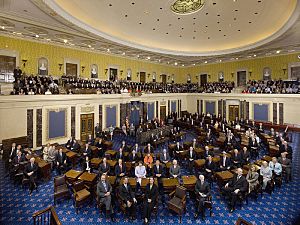History of the United States Senate facts for kids
The United States Senate is an important part of the United States Congress. It's like the "upper house" of Congress, while the United States House of Representatives is the "lower house." Together, they make up the part of the U.S. government that creates laws.
The Senate was created by the Constitution of the United States and first met on March 4, 1789, in New York City. Its history actually started earlier, during the 1787 Constitutional Convention. At this meeting, leaders like James Madison suggested having two parts to the national law-making body. This idea, called the bicameral (two-chamber) legislature, was part of the Connecticut Compromise. This agreement helped decide how many representatives each state would have in the new Congress, making sure both small and large states felt fairly represented.
Contents
How the Senate Was Created
The U.S. Senate was named after the ancient Roman Senate. It was designed to be a more thoughtful and careful group than the House of Representatives. Leaders like James Madison believed the Senate would make decisions with "more coolness, with more system, and with more wisdom."
Senators serve six-year terms, which is longer than the two-year terms for members of the House. This longer term helps senators focus on the country's long-term interests rather than just what's popular at the moment. Having fewer members and staggered terms (meaning not all senators are up for election at the same time) also helps the Senate work together more closely.
Many of the Founding Fathers of the United States admired the British system of government. They saw the Senate as an American version of the British House of Lords. For example, John Dickinson thought the Senate should include "the most distinguished characters." The Senate was also created to give smaller states the same power as larger states, especially since larger states have more representation in the House.
Fair Representation for All States
The way senators are chosen was a big topic during the Constitutional Convention. Some, like Alexander Hamilton, felt it wasn't fair for states with very different populations to have the same number of senators. However, each state delegation at the Convention had an equal vote.
Even though states representing most Americans might have wanted representation based on population, smaller states pushed for equal representation. They worried they wouldn't have enough say otherwise. In the end, the "Connecticut Compromise" was reached. This agreement gave each state two senators, no matter how many people lived there. This was a key compromise to ensure all states would join the new United States.
James Madison, often called the "Father of the Constitution," admitted that equal representation in the Senate was a compromise. It wasn't based on a perfect idea, but on the need for states to agree and work together.
Over time, the difference in population between states has grown a lot. In 1789, the biggest state, Virginia, had only about 12 times more people than the smallest, Delaware. Today, California has about 70 times more people than Wyoming. This means a smaller percentage of the U.S. population can elect a majority of senators today compared to when the country started.
Early Years of the Senate (1789–1865)
In its early days, the Senate met almost in secret. For five years, no public notes were kept of their meetings.
The role of the Vice President of the United States, who is also the President of the Senate, was debated early on. The first Vice President, John Adams, often attended Senate sessions. However, later Vice Presidents usually only attended on special occasions.
In 1797, Thomas Jefferson, who was then Vice President, started the tradition of only attending the Senate for important events. Even so, he created the "Manual of Parliamentary Practice for the Use of the Senate of the United States" in 1801, which is still used today to guide Senate procedures.
The years before the American Civil War are sometimes called the "Golden Age" of the Senate. During this time, the Senate became very respected. Famous senators like John C. Calhoun, Daniel Webster, and Henry Clay were very influential. They often had more public attention than some presidents.
One of the most famous debates in Senate history was the Webster–Hayne debate in January 1830. It was a big discussion about the interests of different parts of the country.
Before the Civil War, there were two major arguments about the balance of power between slave states and free states in the Senate.
- The Missouri Compromise of 1820, helped by Henry Clay, allowed Maine to join as a free state to keep the number of free and slave states equal.
- The Compromise of 1850, also helped by Henry Clay and Stephen A. Douglas, further tried to balance these interests and helped delay the Civil War.
The Senate After the Civil War (1865–1913)
After the Civil War, the Senate dealt with major national issues like Reconstruction (rebuilding the country after the war) and money policies. During this time of rapid industrial growth, many wealthy business leaders became senators.
From 1871 to 1898, the Senate was very careful about approving international agreements. They often blocked trade deals and other agreements with foreign countries. For example, they almost didn't approve the treaty that ended the Spanish–American War in 1898.
Changes in the Early 20th Century (1913–1945)
The Senate saw big changes during Woodrow Wilson's presidency.
- In 1913, the 17th Amendment was passed. This was a huge change! Before this, state legislatures chose senators. But the 17th Amendment made it so that people directly vote for their senators.
- Another change was limiting the "filibuster." A filibuster is when a senator tries to delay a vote on a bill by talking for a very long time. This tactic was limited in response to a filibuster during World War I that tried to stop the arming of merchant ships.
- The role of Senate Majority Leader was also created during this time. This person leads the main political party in the Senate.
In 1922, Rebecca Latimer Felton became the first woman to serve in the Senate, though she only served for one day. In 1932, Hattie Caraway became the first woman to be elected to the Senate.
In 1937, the Senate disagreed with President Franklin D. Roosevelt's plan to add more justices to the Supreme Court, often called his "court packing" plan. They successfully pushed for reduced government spending.
The Senate Since 1945
In the early 1950s, Senator Joseph McCarthy from Wisconsin led investigations into people he claimed were communists. After years of making accusations, he was criticized by the Senate in 1954 because he couldn't provide enough evidence for his claims.
The Senate Majority Leader's power grew significantly after World War II. In 1937, a rule was created that gave the Majority Leader the right to be recognized first when speaking. This gave them much more control over which bills would be discussed and voted on.
During Lyndon B. Johnson's time as Senate leader, the leader gained even more power over who was assigned to different committees.
In 1971, Paulette Desell became the Senate's first female page (a person who helps senators). In 2009, Kathie Alvarez became the Senate's first female legislative clerk (a person who helps with official documents).
Images for kids





